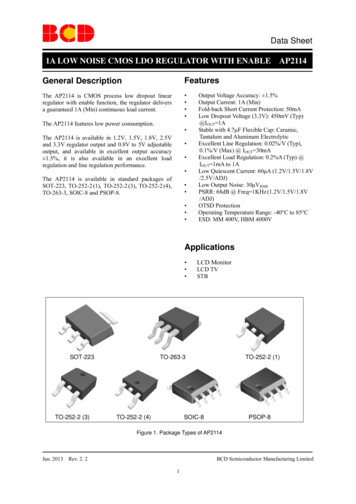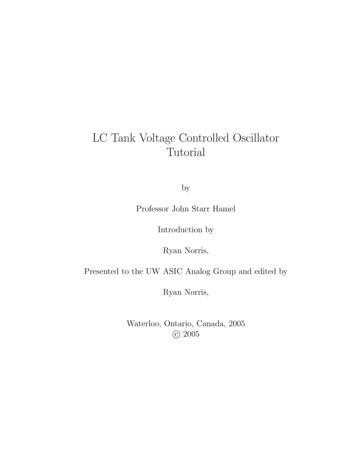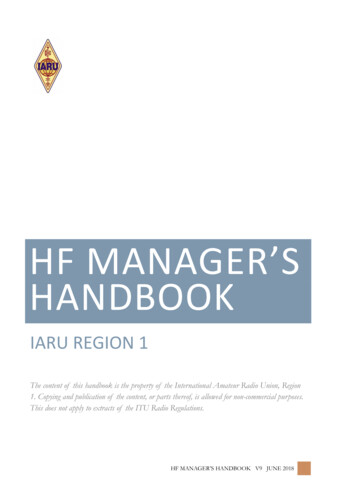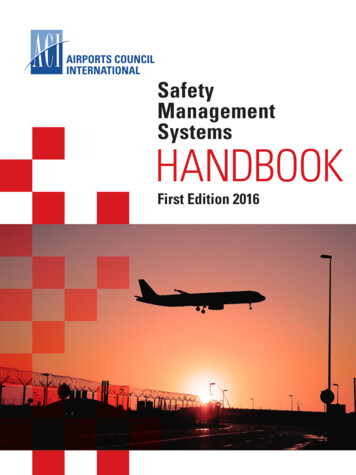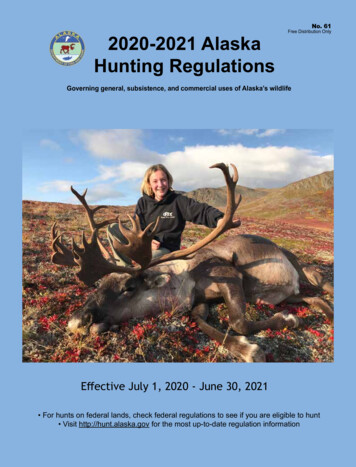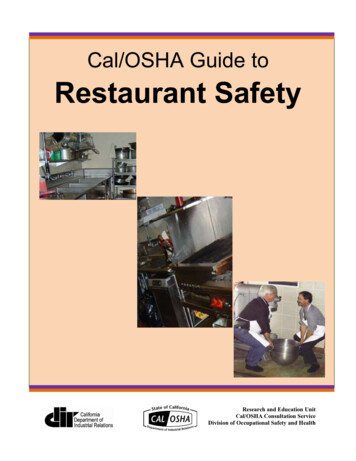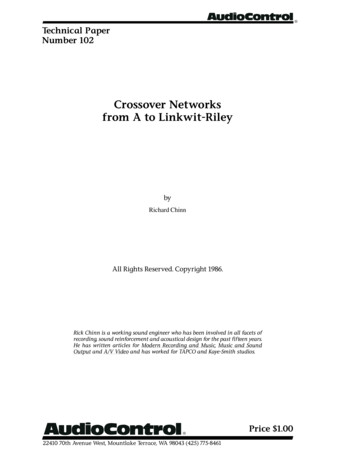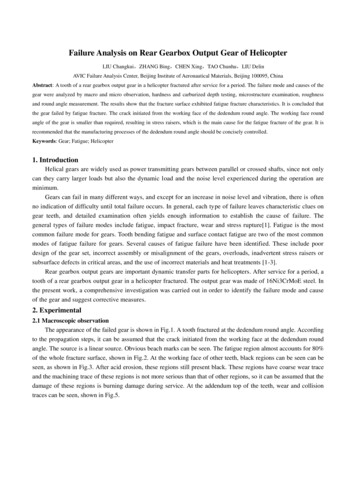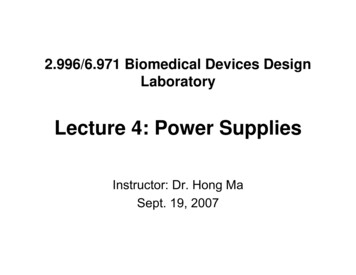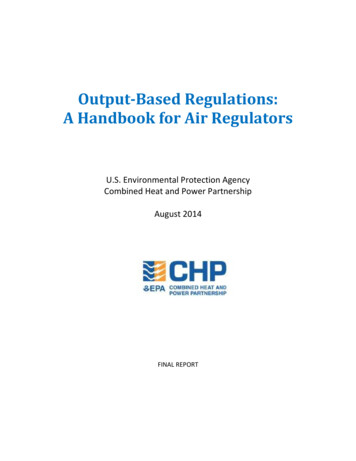
Transcription
Output-Based Regulations:A Handbook for Air RegulatorsU.S. Environmental Protection AgencyCombined Heat and Power PartnershipAugust 2014FINAL REPORT
This handbook was prepared by ICF International and ERG Inc., under contract to the U.S. EnvironmentalProtection Agency. The Combined Heat and Power Partnership (CHPP) would like to thank Rich Sedanoand Rick Weston of the Regulatory Assistance Project and Christian Fellner of EPA’s Office of Air QualityPlanning and Standards for their thoughtful review of the handbook.Output-Based Regulations:A Handbook for Air Regulatorsii
Table of ContentsEXECUTIVE SUMMARY . 1What is an output-based regulation? .1Why adopt output-based regulations? .1How do I develop an output-based emission standard? .2How do I comply with an output-based emission standard?.3Who has developed output-based regulations? .3Section 1.Introduction . 1-11.1 Purpose of the Handbook . 1-11.2 Trends Supporting Increased Use of Output-Based Regulation . 1-21.3 Using the Handbook . 1-3Section 2.What Is An Output-Based Regulation? . 2-12.1 Output-Based Units of Measure . 2-12.2 Output-Based Standards Under the Clean Air Act . 2-1Section 3.Why Adopt Output-Based Regulations? . 3-13.1 Emission Reduction Benefits of Output-Based Regulation . 3-13.1.13.1.2Output-Based Emission Standards . 3-1Output-Based Allowance Allocations in Emission Trading Programs . 3-43.2 Cost Reductions from Output-Based Regulations . 3-63.3 Output-Based Format as a Measure of Environmental Performance . 3-73.4 Output-Based Regulation and Combined Heat and Power Applications. 3-83.4.13.4.2Section 4.What Is Combined Heat and Power? . 3-8What Are the Benefits of Combined Heat and Power? . 3-9How Do I Develop An Output-Based Emission Standard?. 4-14.1 Develop the Output-Based Emission Limit . 4-14.1.14.1.24.1.3Conversion from Input-Based Emission Limit (lb/MMBtu/heat input) . 4-1Conversion from Flue Gas Concentration Limit (ppmv) . 4-4Conversion from Emission Limit Based on Mechanical Power (g/bhp-hr) . 4-44.2 Specify a Gross or Net Energy Output Format . 4-54.3 Specify Compliance Measurement Methods. 4-64.4 Specify How to Calculate Emission Rates for Combined Heat and Power Units . 4-64.5 Summary of Steps to Develop an Output-Based Standard . 4-104.6 Summary of Steps to Comply with an Output-Based Standard . 4-11Section 5.Examples of Output-Based Regulations . 5-15.1.15.1.2Units of Measure . 5-3Net Versus Gross Energy Output . 5-3Output-Based Regulations:A Handbook for Air RegulatorsiiiTable of Contents
Table of Contents (Continued)5.1.35.1.45.1.5Selection of the Emission Limit for New Units . 5-4Modified and Reconstructed Units . 5-5Treatment of Combined Heat and Power Plants . 5-65.1.6NSPS CO2 Limits . 5-65.2.2Treatment of Combined Heat and Power . 5-85.3.2Availability, Measurement, and Reporting of Output Data . 5-95.2 RAP National Model Emission Rule for Distributed Generation . 5-75.2.1Format of the Rule . 5-75.3 EPA Guidance on Output-Based NOx Allowance Allocations . 5-85.3.1Allocation of Allowances . 5-95.4 Utility Boiler Maximum Achievable Control Technology Standards . 5-115.4.1Allocation of Allowances .5-11Output-Based Regulations:A Handbook for Air RegulatorsivTable of Contents
List of AppendicesAppendix A: Energy Conversion Factors . A-1Appendix B: Existing Output-Based Regulations . B-1B.1 Conventional Emission Rate Limit Programs . B-1B.1.1New Source Performance Standards for Utility Boilers . B-1B.1.4Mercury MATS . B-3B.1.2B.1.3New Source Performance Standards for Stationary Combustion Turbines . B-1New Jersey Mercury Emission Limitations. B-2B.2 Regulations for Distributed Generation . B-3B.2.1New Hampshire Emission Fee . B-3B.2.4Rhode Island Distributed Generation Rule . B-8B.2.2B.2.3B.2.5B.2.6B.2.7B.2.8B.2.9California Senate Bill 1298 Regulations for Distributed Generation . B-4Delaware Small Distributed Generation Rule . B-8Texas Standard NOx Permit for Distributed Generation . B-8Texas Permit by Rule . B-9Regulatory Assistance Project Model Rule for Distributed Generation. B-10Connecticut Air Pollution Regulations 22a-174-42 . B-11Maine Permit for Small-Scale Electric Generators. B-12B.2.10 Massachusetts Draft 310 CMR 7.26 Engines and Combustion Turbine CertificationStandards . B-13B.2.11 New York 6 NYCRR Part 222 Emissions from Distributed Generation . B-14B.3 Allowance Allocation in Emission Trading Programs . B-15B.3.1Arkansas . B-16B.3.4Indiana . B-17B.3.2B.3.3B.3.5B.3.6B.3.7B.3.8B.3.9Connecticut . B-16Illinois. B-17Massachusetts . B-17Missouri . B-17New Hampshire. B-18New Jersey. B-18New York . B-18B.3.10 Ohio . B-19B.3.11 Pennsylvania . B-19B.3.12 Wisconsin . B-19B.4 State Multi-Pollutant Programs . B-19B.4.1B.4.2Massachusetts Multi-Pollutant Program . B-19New Hampshire Multi-Pollutant Program . B-21Output-Based Regulations:A Handbook for Air RegulatorsvList of Appendices
List of Appendices (Continued)B.5 Emission Performance Standards. B-22B.5.1California. B-23B.5.4Washington . B-24B.5.2B.5.3B.5.5B.5.6B.5.7New York . B-23Oregon. B-24NSPS for New Power Plants . B-24Proposed NSPS for New Stationary EGUs, Section 111(b) of the CAA . B-25Boiler MACT Regulations . B-26B.6 New Source Review . B-27Output-Based Regulations:A Handbook for Air RegulatorsviList of Appendices
List of TablesTable ES-1. Current Output-Based Treatment of CHP . 4Table 2-1. Output-Based Units of Measure . 2-1Table 3-1. Design Flexibility Offered by Output-Based Standard . 3-7Table 3-2. Conventional and Output-Based Measurements for Electricity Generation . 3-8Table 3-3. Typical P/H Ratios for Common CHP Technologies . 3-9Table 4-1. Displaced Boiler Emission Rate (lb/MWhelectric) for CHP Units . 4-9Table 4-2. Summary of Rule Development Steps .4-10Table 5-1. List of Current Output-Based Programs . 5-1List of Tables (Appendices)Table B-1. 2003 California Distributed Generation Certification Standards (lb/MWh) . B-5Table B-2. 2007 California Distributed Generation Fossil Fuel Emission Standards (lb/MWh) . B-5Table B-3. 2007 California Distributed Generation Waste Gas Emission Standards (lb/MWh) . B-5Table B-4. CARB BACT Guidance for Small Combustion Turbines* . B-7Table B-5. CARB BACT Guidance for Reciprocating Engine Generators* . B-7Table B-6. TCEQ Standard Permit for NOx from DG . B-9Table B-7. TCEQ PBR for CHP . B-9Table B-8. RAP Model Rule Emission Limits (lb/MWh) . B-10Table B-9. Connecticut Emission Standards for New Distributed Generators. B-11Table B-10. Connecticut Emission Standards for Existing Distributed Generators. B-11Table B-11. Maine Emission Standards for Non-Emergency Generators . B-12Table B-12. Massachusetts Emission Limits for Emergency Engines and Turbines . B-13Table B-13. Massachusetts Emission Limits for Non-Emergency Engines. B-13Table B-14. Massachusetts Emission Limits for Non-Emergency Turbines . B-14Table B-15. CO2 Emission Limitations—Engines and Turbines . B-14Table B-16. Proposed NOx Emission Limits . B-15Table B-17. Massachusetts Multi-Pollutant Program Emission Limits . B-20Table B-18. Massachusetts’ Proposed Mercury Emission Regulations . B-21Table B-19. NESCAUM Model Rule Emission Performance Standards . B-23List of FiguresFigure 3-1a. Benefits of Output-Based Regulation . 3-3Figure 3-1b. Benefits of Output-Based Regulation . 3-3Figure 3-2. Two Typical CHP Configurations . 3-9Figure 3-3. Efficiency Benefits of CHP.3-10Figure 3-4. Emission Benefits of CHP .3-11Output-Based Regulations:A Handbook for Air RegulatorsviiTables and Figures
EXECUTIVE SUMMARYThe Combined Heat and Power Partnership (CHPP), within the U.S. EPA’s Climate ProtectionPartnerships Division (CPPD), developed this handbook. CPPD’s voluntary partnerships work to increasethe understanding of the full range of greenhouse gas (GHG) and air quality benefits provided by energyefficiency and clean energy production. Output-based regulations can help air regulators incorporatethese benefits into their programs.The CHPP is a voluntary program that reduces the environmental impact of power generation byfostering the use of CHP. CHP, also known as cogeneration, produces both heat and electricity from asingle heat input. CHP is a more efficient, cleaner, and more reliable alternative to conventionalgeneration. The partnership works closely with the CHP industry, state and local governments, and otherstakeholders to develop tools and services to support the development of new CHP projects andrecognize their energy, environmental, and economic benefits. The use of output-based regulations is atool that can foster the expansion of CHP.This handbook was developed to assist air regulators in developing emission regulations that recognizethe pollution prevention benefits of efficient energy generation technologies. It is also intended to helpCHP project owners better understand and comply with output-based environmental regulations. Cleanenergy technologies prevent pollution by using less fuel and, thus, reducing associated emissions.Output-based regulations encourage energy efficiency by relating emissions to the productive output ofthe process, not to the amount of fuel burned.While output-based regulations have been used for many industries, boilers and power generationsources have traditionally been regulated through input-based regulations. This has been changingrecently, though, as regulators seek to promote air emission reductions and provide more complianceflexibility to combustion sources.The CHPP developed this handbook to assist state, local, and tribal regulators in developing outputbased regulations. The handbook provides practical information to help regulators decide if they wantto use output-based regulations and explains how to develop an output-based emission standard.What is an output-based regulation?Output-based regulations include output-based emission standards as well as output-based allocationsof emission allowances within a cap and trade program. An output-based emission standard relatesemissions to the productive output of the process. Output-based emission standards use units ofmeasure such as lb emission/MWh generated or lb emissions/MMBtu of steam generated, rather thanheat input (lb/MMBtu) or pollutant concentration (ppm). In a cap and trade program, emissionallowances can be allocated to energy generation sources based on energy output (e.g., electricity orsteam generated) rather than fuel burned (i.e., heat input).Why adopt output-based regulations?The primary benefit of output-based regulations is that they encourage efficiency and pollutionprevention. More efficient combustion technologies benefit from the use of output-based regulations.Output-Based Regulations:A Handbook for Air Regulators1Executive Summary
The use of these technologies reduces fossil fuel use and leads to multi-media reductions in theenvironmental impacts of the production, processing, transportation, and combustion of fossil fuels. Inaddition, reducing fossil fuel combustion is a pollution prevention measure that reduces emissions of allproducts of combustion, not just the target pollutant of a regulatory program.Another benefit is that output-based standards allow sources to use energy efficiency as part of theiremission control strategy. Allowing energy efficiency as a control measure provides regulated sources,either existing or new, with an additional compliance option that can lead to reduced compliance costsas well as lower emissions. Input- or concentration-based standards do not provide this option.In a cap and trade program, states can design an output-based allowance allocation system toaccomplish a number of environmental objectives. For example, a program that periodically updatesoutput-based allocations encourages increased energy efficiency because sources vie for a larger shareof the allocations. A program that allocates output-based allowances to non-emitting electricitygenerators during these periodic updates provides a financial incentive for the introduction ofrenewable energy sources, such as wind power. EPA developed guidance for states on how to developoutput-based allocations under the NOx Budget Trading Program in May 2000, 1 and the CHPP has morerecently issued whitepapers and other assistance primarily to help state regulators better understandoutput-based regulations and navigate the process of developing such standards. In addition to thisguide, the CHPP issued Accounting for CHP in Output-Based Regulations 2 in February 2013 and OutputBased Environmental Regulations: An Effective Policy to Support Clean Energy Supply 3 in September2011.How do I develop an output-based emission standard?Several decisions must be made about the format of the rule. Making these decisions involves trade-offsbetween the degree to which the rule will account for the benefits of energy efficiency, the complexityof the rule, and the ease of measuring compliance.The steps for developing an output-based emission standard are: Develop the output-based emission limit. The method that is used will depend on whether ornot measured energy output data are available. Specify a gross or net energy output format. Net energy output more comprehensivelyaccounts for energy efficiency, but can increase the complexity of compliance monitoringrequirements. Specify compliance measurement methods. Output-based standards require designatingmethods for monitoring electrical, thermal, and mechanical outputs. Instruments tocontinuously monitor and record energy output are routinely used and are commerciallyavailable at a reasonable cost.1EPA. 2000. Developing and Updating Output-Based NOx Allowance Allocations: Guidance for States Joining the NOx BudgetTrading Program Under the NOx SIP Call. urces.html.3http://epa.gov/chp/documents/output based regs fs.pdf.Output-Based Regulations:A Handbook for Air Regulators2Executive Summary
Specify how to calculate emission rates for CHP units. For CHP units, the standard must accountfor multiple energy outputs. This handbook describes two typical approaches.How do I comply with an output-based emission standard? Determine compliance procedures. Compliance forms, permit forms, or other necessarydocumentation must be obtained. The output-based methodology that is used will depend onwhether measured energy output data are available. Determine the data necessary for compliance. Review the compliance calculation and otherinputs to determine what data are needed to calculate the emission limit from the CHP system.Electric output data (typically measured in MWh) and thermal output (measured in MMBtu) areoften required. Implement appropriate data collection procedures. Install appropriate emission and outputmeasurement devices (electric and thermal) and collect emission and output data. Calculate compliance. Use the required calculation to determine the output-based emissions orother output-based feature for the CHP system. Submit completed forms to the state utility regulatory agency or other appropriate authority.Who has developed output-based regulations?A number of federal, regional, and state programs have adopted output-based emission regulations,including emission standards for large and small generators, cap and trade allowance allocation systems,multi-pollutant regulations, and generation performance standards (Table ES-1).To provide additional insight into the technical and policy considerations of setting output-basedstandards, this handbook describes four output-based emission reduction programs. These programsare: The output-based approach that EPA used to revise the electric utility boiler New SourcePerformance Standard (NSPS) (40 CFR Part 60, Subpart Da). This action reflected a major changein approach for the NSPS and provided an efficiency-based rationale for transitioning to outputbased regulation. When originally promulgated in 1998, it was the first NSPS for boilers thatincorporated output-based emission limits; it allows CHP systems to account for 75 percent oftheir secondary thermal output. This section also discusses EPA’s proposed GHG NSPS for newpower plants. A model rule for output-based standards for small electric generators. The model rule is a goodexample of a straightforward output-based emission limit program that recognizes the thermaloutput of CHP. EPA’s guidance on how to allocate emission allowances for the NOx SIP Call and Clean AirInterstate Rule (CAIR) based on energy output. The NOx SIP Call approach was developed by aOutput-Based Regulations:A Handbook for Air Regulators3Executive Summary
stakeholder group of EPA, states, industry, and environmental groups. The guidance thoroughlydiscusses how output-based allocation can be applied. 4 EPA’s output-based approach in its Boiler Maximum Achievable Control Technology (MACT)regulations (40 CFR Part 63, Subpart DDDDD). This rule, finalized in December 2012, applies toindustrial, commercial, and institutional boilers and process heaters. The rule containsprovisions for boiler/steam turbine CHP to account for their secondary electricity output.Output-based regulations are continuing to gain attention as EPA, states, and regional planningorganizations strive to find innovative ways to attain today’s air quality goals. Emissions from energyproduction processes contribute to a number of air pollution problems, including fine particulates,ozone, acid rain, air toxics, visibility degradation, and climate change. An output-based regulation can beused as part of a regulatory strategy that encourages pollution prevention and the use of innovative andefficient energy-generating technologies. Adopting output-based regulations, therefore, is a valuabletool for protecting air quality while fostering the development of efficient, reliable, and affordablesupplies of energy.Table ES-1. Current Output-Based Treatment of CHPType of ProgramFederal NSPS regulationsRegulatory PurviewNSPS for Stationary Combustion TurbinesNSPS for Industrial-CommercialInstitutional Steam Generating UnitsNSPS for Stationary Compression IgnitionInternal Combustion EnginesNSPS for Stationary Spark IgnitionInternal Combustion EnginesNSPS for Aluminum Reduction PlantsNSPS for Electric Steam Generating UnitsNational EmissionStandards for HazardousAir Pollutants (NESHAP)Conventional stateemission rate limitsNESHAP for Area/Sources: Electric ArcFurnace Steelmaking FacilitiesNESHAP for Industrial, Commercial, andInstitutional Boilers and Process Heaters(Boiler MACT)NESHAP for Coal- and Oil-Fired ElectricUtility Steam Generating Units (MATSrule)New Jersey mercury emission limitsOutput-Based FeaturesEmission limit (lb/MWh) gross outputEmission limit (lb/MWh) gross outputEmission limit (g/KW-hr)Emission limit (g/HP-hr)Emission limit (kg/Mg) or (lb/ton)Emission limit (lb/MWh) gross outputand (lb/MWh) net outputEmission limit (lb/ton)Emission limit (lb/MBtu) steam outputor (lb/MWh)Emission limit (lb/MWh) or (lb/GWh)Emission limit (mg/MWh)4EPA first regulated the transport of NOx in 1998 with the promulgation of the NOx SIP Call and its NOx Budget Trading Program.Several years later, with the goal of further increasing NOx reductions and helping states attain PM2.5 standards, EPA issued theCAIR in 2005. In 2011, EPA finalized the Cross-State Air Pollution Rule to achieve even greater emissions reductions that reflectmore stringent air quality standards. For more information about these rules, their cap and trade programs, and their interrelated history, go to: http://www.epa.gov/airtransport/CSAPR/ and Based Regulations:A Handbook for Air Regulators4Executive Summary
Table ES-1. Current Output-Based Treatment of CHPType of ProgramState emission standardsfor distributed generationState NOx budget tradingprogramsCAIR state programsRegional Gr
The CHPP developed this handbook to assist state, local, and tribal regulators in developing output-based regulations. The handbook provides practical information to help regulators decide if they want to use output-based regulations and explains how to develop an output-based emission s

